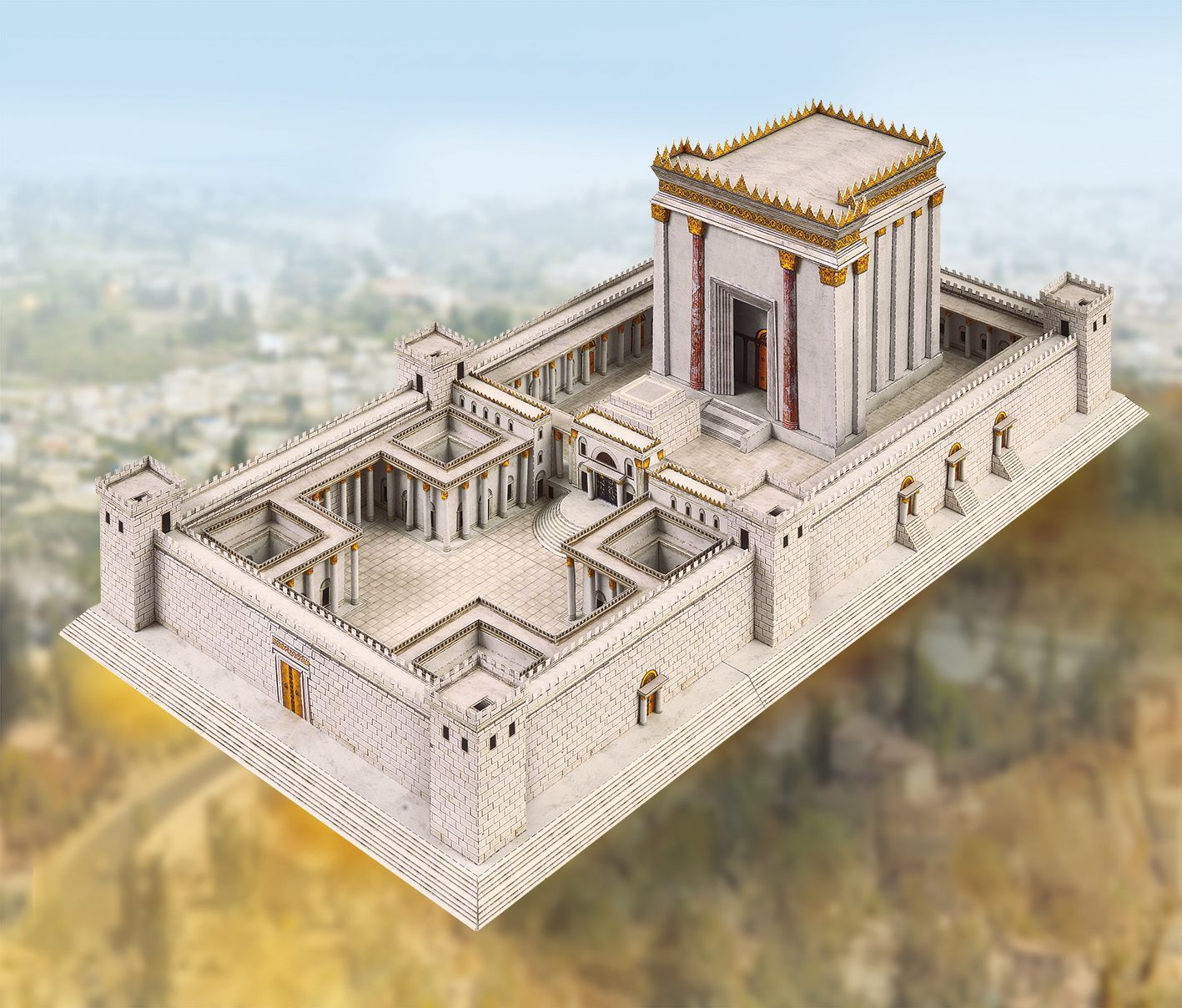Tempel in Jerusalem
L/H/B/ 55x29x16 cm. Measure 1:400. series with 15,5 sheets A4.
The temple in Jerusalem at the time of Jesus. King Solomon had built the first temple in Jerusalem. It was destroyed by the Babylonians when they conquered Jerusalem and took a part of the population to Babylon. When they returned home, the now ruling Persians allowed the temple to be rebuilt. This “second temple” was completed in 515. It stood on the same place as the temple of Solomon. Centuries later King Herod (37-4 B.C.) rebuilt the temple, beautified and enlarged the entire temple complex to an area of 500 x 300 meters. Massive masses of earth were piled up. The forecourts were terraced, so that the temple building stood exactly in the middle and looked even more elevated. According to a report by the Roman historian Flavius Josephus, the temple building was 45-50 metres long and 54-60 metres high. He described the temple in Jerusalem as “one of the greatest buildings one has ever heard of” (Flavius Josephus: Jewish Antiquities). On the north-western side of the temple grounds was Baris Castle, from the Maccabees period, which was extended by Herod and renamed “Antonia Castle”. From here the Roman soldiers could watch over the temple. The main entrance in the west of the temple led into the forecourt of the pagans, which was surrounded by column galleries. This was also where the halls were located in which the people taught and traded. In the middle of the front courtyard of the pagans was the actual temple district, which the model depicts. It was a little higher and accessible through nine gates. The most magnificent gate was called the “Beautiful Gate”. Only Jews were allowed to enter the temple district. All people of other faiths were forbidden to enter the temple district under the death penalty. This is reported in the Bible, for example, in Acts of the Apostles. Stones with inscriptions indicating the death penalty were found during excavations. The actual temple district was divided into three further atriums. The first atrium was open to women. The adjoining atrium of the Israelites was reserved for men. Only the priests were allowed to enter the third courtyard. In this forecourt of the priests, slaughtered cattle, goats, sheep and pigeons were burned on a nine metre long altar of burnt offerings. Beside it stood six tank wagons with water for cleaning the sacrificial meat and a large bronze water basin, 4.50 metres in diameter, with a capacity of 75,000 litres, which was carried by twelve bronze cattle figures. Only priests were allowed to enter the temple. Through the open entrance they entered the priest’s vestibule and through a large door into the holy place. There stood the large seven-armed candelabrum made of gold and the table on which six loaves of bread were laid on top of each other twice a week on the Sabbath, the holiday of the Jews. On the altar of incense a priest burned aromatic herbs in the morning and in the evening. Separated from the saint by a curtain was the Blessed Sacrament. Only the high priest was allowed to enter this room once a year on the Day of Atonement (Yom Kippur). The Blessed Sacrament was completely dark and empty. Here the ark of the covenant should have stood, in which the stone tablets with the ten commandments lay. However, the Ark had disappeared since Solomon’s temple was destroyed in 586 BC. The Blessed Sacrament was the place where God was among his people. The curtain stood as a symbol of the separation between God and man. According to the Bible (Matthew 27:51), the curtain was torn when Jesus died on the cross. The white temple was richly decorated with gold and precious stones. The Bible reports in the New Testament how Jesus was made aware of the beauty of the building by his disciples. He then prophesied that no stone of this building would remain on the other. In fact, the temple was destroyed by the Romans in 70 AD. They took the treasures in the temple, including the seven-armed candelabrum, with them to Rome. The temple foundations remained on the west side. They form the so-called Wailing Wall, where the pious Jews pray to God and complain about their destroyed temple until today. Today there are two sanctuaries of Muslims on the Temple Mount: the Dome of the Rock with its widely visible golden dome and the Al-Aqsa Mosque.

